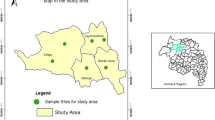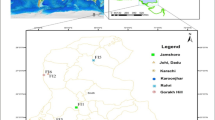Abstract
Roots of wild Paeonia lactiflora are often used as herbs in traditional Chinese medicine. In this study, the contents of potassium (K), calcium (Ca), phosphorus (P), magnesium (Mg), iron (Fe), manganese (Mn), copper (Cu), and zinc (Zn) and the concentrations of three active ingredients such as paeoniflorin (PF), catechin (CA) and benzoic acid (BA) in roots of wild P. lactiflora collected from Duolun County of Inner Mongolia in China were evaluated. The results showed that the mean contents of eight elements followed the following order: Ca > K > P > Mg > Fe > Zn > Mn > Cu, and the concentrations of three active ingredients decreased in the order: PF > CA > BA. It was found that PF concentration was positively correlated with the contents of Fe and Mn. However, the concentration of CA was linearly decreased with Mg content. Moreover, BA concentration showed positive linear dependence upon the contents of P and Mn. Results of stepwise regression analyses showed that 39.2% of the variance in PF concentration could be explained by Fe content, whereas 28.1% of the CA concentration changes could be explained by Mg content; moreover, 42.5% of the variance in BA concentration could be accounted for by the combination of Mn and P contents. In a word, the concentrations of active ingredients in roots of P. lactiflora can be changed by adjusting mineral elements levels in roots to meet the need of appropriate quality control of P. lactiflora.




Similar content being viewed by others
References
Heubl G (2013) DNA-based authentication of TCM-plants: current progress and future perspectives. In: Wagner H, Ulrich-Merzenich G (eds) Evidence and rational based research on Chinese drugs, 1st edn. Springer, Vienna, pp 27–85
Jiang Z, Ma L (2001) Regions in China rich in resource for medicinal plants. In: Lin Y (ed) Drug discovery and traditional Chinese medicine: science, regulation, and globalization, 1st edn. Springer, Boston, pp 55–60
Jia W, Zhang L (2005) Challenges and opportunities in the Chinese herbal drug industry. In: Zhang L, Demain AL (eds) Natural products: drug discovery and therapeutic medicine, 1st edn. Humana Press, Totowa, pp 229–250
Zhao ZZ, Guo P, Brand E (2012) The formation of daodi medicinal materials. J Ethnopharmacol 140:476–481. https://doi.org/10.1016/j.jep.2012.01.048
Chinese Pharmacopoeia Committee (2015) Pharmacopoeia of the People’s Republic of China. China Medical Science Press, Beijing (in Chinese)
Liang J, Xu F, Zhang YZ, Huang S, Zang XY, Zhao X, Zhang L, Shang MY, Yang DH, Wang X, Cai SQ (2013) The profiling and identification of the absorbed constituents and metabolites of Paeoniae Radix Rubra decoction in rat plasma and urine by the HPLC–DAD–ESI-IT-TOF-MSn technique: a novel strategy for the systematic screening and identification of absorbed constituents and metabolites from traditional Chinese medicines. J Pharm Biomed Anal 83:108–121. https://doi.org/10.1016/j.jpba.2013.04.029
Li SL, Song JZ, Choi FFK, Qiao CF, Zhou Y, Han QB, Xu HX (2009) Chemical profiling of Radix Paeoniae evaluated by ultra-performance liquid chromatography/photo-diode-array/quadrupole time-of-flight mass spectrometry. J Pharm Biomed Anal 49:253–266. https://doi.org/10.1016/j.jpba.2008.11.007
Bae JY, Kim CY, Kim HJ, Park JH, Ahn MJ (2015) Differences in the chemical profiles and biological activities of Paeonia lactiflora and Paeonia obovata. J Med Food 18:224–232. https://doi.org/10.1089/jmf.2014.3144
Díaz-Gómez R, Toledo-Araya H, López-Solís R, Obreque-Slier E (2014) Combined effect of gallic acid and catechin against Escherichia coli. LWT Food Sci Technol 59:896–900. https://doi.org/10.1016/j.lwt.2014.06.049
Cotoras M, Vivanco H, Melo R, Aguirre M, Silva E, Mendoza L (2014) In vitro and in vivo evaluation of the antioxidant and prooxidant activity of phenolic compounds obtained from grape (Vitis vinifera) pomace. Molecules 19:21154–21167. https://doi.org/10.3390/molecules191221154
Ngan LTM, Moon JK, Shibamoto T, Ahn YJ (2012) Growth-inhibiting, bactericidal, and urease inhibitory effects of Paeonia lactiflora root constituents and related compounds on antibiotic-susceptible and -resistant strains of Helicobacter pylori. J Agric Food Chem 60:9062–9073. https://doi.org/10.1021/jf3035034
Miyazawa M, Maruyama H, Kameoka H (1984) Essential oil constituents of “PAEONIAE RADIX” Peaonia lactiflora Pall. (P. albilora Pall.). Agric Biol Chem 48:2847–2849. https://doi.org/10.1271/bbb1961.48.2847
Delaney MF, Pasko KM, Mauro DM, Gsell DS, Korologos PC, Morawski J, Krolikowski LJ, Warren FV (1985) Determination of aspartame, caffeine, saccharin, and benzoic acid in beverages by high performance liquid chromatography: an undergraduate analytical chemistry experiment. J Chem Educ 62:618–620. https://doi.org/10.1021/ed062p618
Sun JB, Gao YG, Zang P, Yang H, Zhang LX (2013) Mineral elements in root of wild Saposhnikovia divaricata and its rhizosphere soil. Biol Trace Elem Res 153:363–370. https://doi.org/10.1007/s12011-013-9684-x
Kolasani A, Xu H, Millikan M (2011) Evaluation of mineral content of Chinese medicinal herbs used to improve kidney function with chemometrics. Food Chem 127:1465–1471. https://doi.org/10.1016/j.foodchem.2011.01.106
Tokalıoğlu Ş (2012) Determination of trace elements in commonly consumed medicinal herbs by ICP-MS and multivariate analysis. Food Chem 134:2504–2508. https://doi.org/10.1016/j.foodchem.2012.04.093
Singh V, Garg AN (1997) Availability of essential trace elements in ayurvedic indian medicinal herbs using instrumental neutron activation analysis. Appl Radiat Isot 48:97–101. https://doi.org/10.1016/S0969-8043(96)00043-7
Subramanian R, Gayathri S, Rathnavel C, Raj V (2012) Analysis of mineral and heavy metals in some medicinal plants collected from local market. Asian Pac J Trop Biomed 2:S74–S78. https://doi.org/10.1016/S2221-1691(12)60133-6
Chizzola R (2012) Metallic mineral elements and heavy metals in medicinal plants. Med Aromat Plant Sci Biotechnol 6:39–53
Ma S, Zhu G, Yu F, Zhu G, Wang D, Wang W, Hou J (2018) Effects of manganese on accumulation of Glycyrrhizic acid based on material ingredients distribution of Glycyrrhiza uralensis. Ind Crop Prod 112:151–159. https://doi.org/10.1016/j.indcrop.2017.09.035
Xu SJ, Yang L, Tian RT, Wang ZT, Liu ZJ, Xie PS, Feng QR (2009) Species differentiation and quality assessment of Radix Paeoniae Rubra (Chi-shao) by means of high-performance liquid chromatographic fingerprint. J Chromatogr A 1216:2163–2168. https://doi.org/10.1016/j.chroma.2008.04.064
Wang D, Wan CY, Wang WQ, Hou JL, Li WD, Wei SL, Yu JB (2012) Effects of manganese deficiency on growth and contents of active constituents of Glycyrrhiza uralensis Fisch. Commun Soil Sci Plant Anal 43:2218–2227. https://doi.org/10.1080/00103624.2012.701684
Singh M, Ali AA, Irfan Qureshi M (2017) Unravelling the impact of essential mineral nutrients on active constituents of selected medicinal and aromatic plants. In: Naeem M, Ansari AA, Gill SS (eds) Essential plant nutrients: uptake, use efficiency, and management. Springer, Cham, pp 183–209
Rehecho S, Hidalgo O, García-Iñiguez de Cirano M, Navarro I, Astiasarán I, Ansorena D, Cavero RY, Calvo MI (2011) Chemical composition, mineral content and antioxidant activity of Verbena officinalis L. LWT Food Sci Technol 44:875–882. https://doi.org/10.1016/j.lwt.2010.11.035
Zhao MX, Lv JR, Yang G, Lin SF, Wu ZG, Song LK, Huang LQ, Guo LP (2009) Effects of inorganic elements in soil on contents of inorganic elements and paeoniflorin in Radix Paeoniae Rubra. Chin J Exp Tradit Med Formulae 15:38–42 (in Chinese)
Prasad A, Kumar S, Pandey A, Chand S (2012) Microbial and chemical sources of phosphorus supply modulate the yield and chemical composition of essential oil of rose-scented geranium (Pelargonium species) in sodic soils. Biol Fertil Soils 48:117–122. https://doi.org/10.1007/s00374-011-0578-9
Zhu ZB, Liang ZS, Han RL, Wang X (2009) Impact of fertilization on drought response in the medicinal herb Bupleurum chinense DC.: growth and saikosaponin production. Ind Crop Prod 29:629–633. https://doi.org/10.1016/j.indcrop.2008.08.002
Nguyen PM, Kwee EM, Niemeyer ED (2010) Potassium rate alters the antioxidant capacity and phenolic concentration of basil (Ocimum basilicum L.) leaves. Food Chem 123:1235–1241. https://doi.org/10.1016/j.foodchem.2010.05.092
Burducea M, Zheljazkov VD, Dincheva I, Lobiuc A, Teliban G-C, Stoleru V, Zamfirache M-M (2018) Fertilization modifies the essential oil and physiology of basil varieties. Ind Crop Prod 121:282–293. https://doi.org/10.1016/j.indcrop.2018.05.021
Cheng X, Zhang XY, Zhang RR, Wang KC (2009) Effects of Mn, Fe, Zn and Cu on growth and paeoniflorin content of Paeonia lactiflora. China J Chin Mater Med 34:961–964 (in Chinese)
Yu JB, Zhang J, Wang WQ, Huang LQ, Feng XF, Cheng M, Ge XG, Yang LJ, Yang JY (2011) Comparative study on content of four constituent between wild and cultivated Radix Paeoniae Rubra. Chin J Exp Tradit Med Formulae 17:107–111. https://doi.org/10.13422/j.cnki.syfjx.2011.18.056 (in Chinese)
Tuo F, Li DH, Zhou FQ, Luo JH, Tuo H, Kong XZ (2010) Determination of trace elements in Chinese medicinal plants by instrumental neutron activation analysis. J Radioanal Nucl Chem 284:507–511. https://doi.org/10.1007/s10967-010-0503-y
dos Santos Magalhães IR, de Oliveira Soares A, Araújo LM, da Costa PRC, de Araújo Roland I, Borrás MRL (2009) Determination of Cu, Fe, Mn, and Zn in the leaves and tea of Arrabidaea chica (Humb. & Bompl.) Verl. Biol Trace Elem Res 132:239–246. https://doi.org/10.1007/s12011-009-8381-2
Ganskopp D, Bohnert D (2003) Mineral concentration dynamics among 7 northern Great Basin grasses. J Range Manag 56:174–184. https://doi.org/10.2307/4003902
Schlegel P, Wyss U, Arrigo Y, Hess HD (2016) Mineral concentrations of fresh herbage from mixed grassland as influenced by botanical composition, harvest time and growth stage. Anim Feed Sci Technol 219:226–233. https://doi.org/10.1016/j.anifeedsci.2016.06.022
Baligar VC, Grunes DL, Belesky DP, Clark RB (2001) Mineral composition of forage legumes as influenced by aluminum. J Plant Nutr 24:215–227. https://doi.org/10.1081/PLN-100001383
Kim J-H, Shin H-K, Seo C-S (2014) Chemical interaction between Paeonia lactiflora and Glycyrrhiza uralensis, the components of Jakyakgamcho-tang, using a validated high-performance liquid chromatography method: herbal combination and chemical interaction in a decoction. J Sep Sci 37:2704–2715. https://doi.org/10.1002/jssc.201400522
Wang Q, Liu RX, Guo HZ, Ye M, Huo CH, Bi KS, Guo DA (2005) Simultaneous LC determination of major constituents in red and white peony root. Chromatographia 62:581–588. https://doi.org/10.1365/s10337-005-0660-2
Zhu S, Yu X, Wu Y, Shiraishi F, Kawahara N, Komatsu K (2015) Genetic and chemical characterization of white and red peony root derived from Paeonia lactiflora. J Nat Med 69:35–45. https://doi.org/10.1007/s11418-014-0857-5
Acknowledgements
We appreciate Lifei Ren, Liyue Gou, and Min Liu for collecting samples and performing experimental assistance.
Funding
This work was funded by the Knowledge Innovation Project of Chinese Academy of Science (15228G1002).
Author information
Authors and Affiliations
Corresponding author
Ethics declarations
Conflict of Interest
The authors declare that they have no conflict of interest.
Additional information
Publisher’s Note
Springer Nature remains neutral with regard to jurisdictional claims in published maps and institutional affiliations.
Rights and permissions
About this article
Cite this article
Li, Z., Liu, D., Zhan, L. et al. Mineral Elements and Active Ingredients in Root of Wild Paeonia lactiflora Growing at Duolun County, Inner Mongolia. Biol Trace Elem Res 193, 548–554 (2020). https://doi.org/10.1007/s12011-019-01725-3
Received:
Accepted:
Published:
Issue Date:
DOI: https://doi.org/10.1007/s12011-019-01725-3




